In the krebs cycle - Study guides, Class notes & Summaries
Looking for the best study guides, study notes and summaries about In the krebs cycle? On this page you'll find 1658 study documents about In the krebs cycle.
Page 4 out of 1.658 results
Sort by
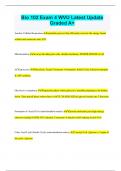
-
Bio 102 Exam 4 WVU Latest Update Graded A+
- Exam (elaborations) • 11 pages • 2024
-
Available in package deal
-
- $9.99
- + learn more
Bio 102 Exam 4 WVU Latest Update Graded A+ Aerobic Cellular Respiration metabolic process that efficiently converts the energy found within food molecules into ATP Mitochondrion in most all eukaryotic cells, double membrane, POWER HOUSE of cell ACR processes Glycolysis, Acetyl Coenzyme A formation, Krebs Cycle, Electron transport & ATP synthase Glycolysis (cytoplasm) Preparatory phase where glucose is unstable preparing to be broken down. Then payoff phase where there is 4ATP, ...
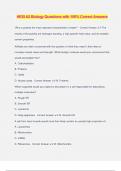
-
HESI A2 Biology Questions with 100% Correct Answers
- Exam (elaborations) • 29 pages • 2024
- Available in package deal
-
- $12.49
- + learn more
HESI A2 Biology Questions with 100% Correct Answers Why is polarity the most important characteristic of water? - Correct Answer ️️ -The results of the polarity are hydrogen bonding, a high specific heat value, and its versatile solvent properties. Athletes are often concerned with the question of what they need in their diets to increase muscle mass and strength. What biologic molecule would you recommend that would accomplish this? A. Carbohydrates B. Proteins C. Lipids D. Nuclei...

-
MCB 2010 Exam 2 Questions with Complete Solutions
- Exam (elaborations) • 20 pages • 2024
-
- $14.49
- + learn more
What is the most common electron carrier in biological systems? Correct Answer-NAD During the process of group translocation, glucose is brought into the cell and is chemically modified into what compound, which prevents it from leaving the cell? Correct Answer-Glucose-6-phosphate Where does the Krebs cycle take place in bacteria? Correct Answer-Cytoplasm For the most part, what type of energy operates cell transactions? Correct Answer-Chemical Which of the following is the substrate...
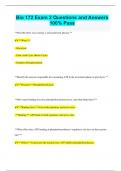
-
Bio 172 Exam 2 Questions and Answers 100% Pass
- Exam (elaborations) • 16 pages • 2024
-
Available in package deal
-
- $9.99
- + learn more
Bio 172 Exam 2 Questions and Answers 100% Pass **Describe three ways energy is extracted from glucose.** **Ways:** - Glycolysis - Citric Acid Cycle (Krebs Cycle) - Oxidative Phosphorylation **Identify the enzyme responsible for consuming ATP in the investment phase of glycolysis.** **Enzyme:** Phosphofructokinase **How many binding sites does phosphofructokinase have, and what binds there?** **Binding Sites:** It has both regulatory and active sites. - **Binding:** ATP bind...
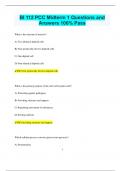
-
BI 112 PCC Midterm 1 Questions and Answers 100% Pass
- Exam (elaborations) • 19 pages • 2024
-
Available in package deal
-
- $9.99
- + learn more
BI 112 PCC Midterm 1 Questions and Answers 100% Pass What is the outcome of meiosis? A) Two identical diploid cells B) Four genetically diverse haploid cells C) One diploid cell D) Four identical diploid cells B) Four genetically diverse haploid cells What is the primary purpose of the cell wall in plant cells? A) Protecting against pathogens B) Providing structure and support C) Regulating movement of substances D) Storing nutrients B) Providing structure and support Which...
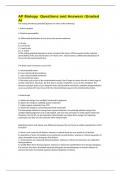
-
AP Biology Questions and Answers (Graded A)
- Exam (elaborations) • 70 pages • 2024
-
- $16.59
- + learn more
AP Biology Questions and Answers (Graded A) The resting membrane potential depends on which of the following? I. Active transport II. Selective permeability III. Differential distribution of ions across the axonal membrane A. III only B. I and II only C. II and III only D. I, II, and III D The resting potential depends on active transport (the Na+K+-ATPase pump) and the selective permeability of the axon membrane to K+ than to Na+, which leads to a differential distribution of ...
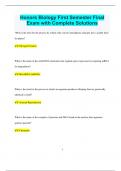
-
Honors Biology First Semester Final Exam with Complete Solutions
- Exam (elaborations) • 17 pages • 2024
- Available in package deal
-
- $9.99
- + learn more
Honors Biology First Semester Final Exam with Complete Solutions What is the term for the process by which cells convert atmospheric nitrogen into a usable form for plants? Nitrogen Fixation What is the name of the small RNA molecules that regulate gene expression by targeting mRNA for degradation? MicroRNA (miRNA) What is the term for the process in which an organism produces offspring that are genetically identical to itself? Asexual Reproduction What is the name of the...
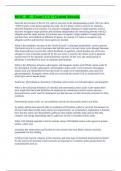
-
BIOC 385 - Exam 3 || A+ Graded Already.
- Exam (elaborations) • 21 pages • 2024
-
Available in package deal
-
- $13.49
- + learn more
Describe the function of the E1, E2, and E3 enzymes in the ubiquitinating system. Why are there ~500 E3 genes in the human genome but only two E1 genes? correct answers E1 enzymes attached ubiquitin to E2 enzymes, E2 enzymes conjugate ubiquitin to target proteins, and E3 enzymes recognize target proteins and facilitate ubiquitination by interacting directly with E2-ubiquitin and the target protein. E3 proteins must recognize a large number of target proteins, and thus there are hundreds of diffe...
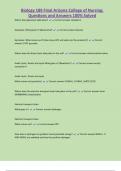
-
Biology 189 Final Arizona College of Nursing; Questions and Answers 100% Solved
- Exam (elaborations) • 12 pages • 2024
- Available in package deal
-
- $11.99
- + learn more
Biology 189 Final Arizona College of Nursing; Questions and Answers 100% Solved Where does glycolysis take place? Correct answer-cytoplasm Glycolysis: What goes in? (Reactants?) Correct answer-Glucose Gylcolysis: What comes out? (How many ATP, and what are the products?) Correct answer-2 ATP. pyruvate Where does the Krebs Cycle take place in the cell? Correct answer-mitochondrial matrix Krebs Cycle / Acetic acid cycle What goes in? (Reactants?) Correct answer-acetyl coenzyme A Krebs ...
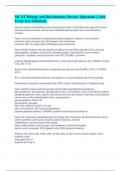
-
MCAT Biology and Biochemistry Review Questions || with Error-free Solutions.
- Exam (elaborations) • 22 pages • 2024
-
- $12.59
- + learn more
How do catalysts and inhibitors affect reaction rates? How is ∆G affected by enzymes? correct answers catalysts increase reaction rates; inhibitors decrease them. ∆G is not affected by enzymes Name 3 ways to determine if something has been oxidized or reduced. correct answers oxidation= gain of oxygen, loss of hydrogen, loss of electrons reduction=loss of oxygen, gain of hydrogen, gain of electrons Name cellular location and end products per glucose for the following: glycolysis, pyru...

Did you know that on average a seller on Stuvia earns $82 per month selling study resources? Hmm, hint, hint. Discover all about earning on Stuvia


